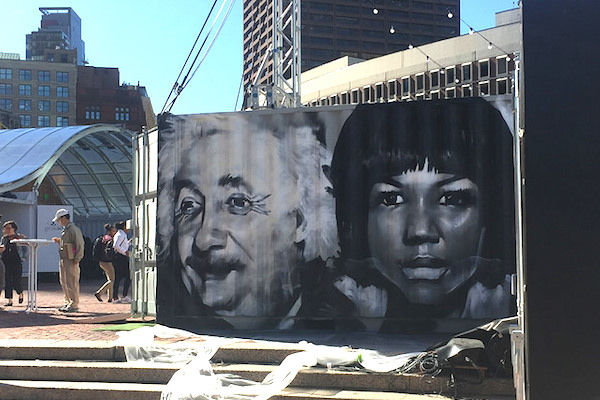THE BEAUTY MYTH
- alberta8
- Jul 28, 2015
- 4 min read
Updated: May 30, 2020

Contributed by Rebecca Ruehlman
Earlier this year, a Smithsonian-branded stall at the National Math Festival in Washington, D.C. gave visitors the chance to put their face through an oval, allegedly to demonstrate whether their face was in accordance with the “divine proportion,” making a judgement call on whether their faces were considered beautiful or not. Unsurprisingly, this caused outrage among the math education community. In an interview with The Independent, Randolph-Macon College mathematics professor, Eve Torrence, said she was appalled by this application of the golden ratio to the human body: “The idea that there’s this one rectangle [based on the golden ratio] that’s this perfect one... and is reflected in the human body, that’s one of the most silly things. Human beings are so different,” said Torrence. “It’s a very loosey-goosey, pseudo-science kind of thing that they are promoting.”
This “pseudo-science” of the mathematically-based beauty myth of facial symmetry has a long history dating back to 1509. Italian mathematician, Luca Pacioli, along with his friend Leonardo daVinci, published a manuscript about what he called the “golden ratio” in his book, The Divine Proportion. Live Science describes the Golden Ratio as:
… a special number found by dividing a line into two parts so that the longer part divided by the smaller part is also equal to the whole length divided by the longer part. It is often symbolized using phi, after the 21st letter of the Greek alphabet. In an equation form, it looks like this: a/b = (a+b)/a =1.6180339887498948420 …”
Photo Credit: Live Science/ Elaine J. Horn
Drawing from this science, the golden ratio theory stated that the closer to the ratio, the more aesthetically beautiful an object was likely to be. It has been noted that the golden ratio has appeared in various forms of nature from shells to spiral galaxies to hurricanes. While most are close to this ratio, it is difficult to find examples where the ratio applies perfectly.
Photo Credits: io9/George Dvorsky
Additionally, Artists and architects have incorporated the ratio into their work. Although it was built prior to Pacioli’s manuscript, the golden ratio was implemented in the design of the Parthenon and daVinci used the ratio to create a mathematically “perfect” face in his Mona Lisa.
However, while the golden ratio theory looks great on paper, or canvas, or in stone, it might not always look so great on human faces. There is a big difference between the theoretical basis for something and reality. Mathematical theories on beauty are no different. Emerson Rosenthal of The Creators Project puts it bluntly- “perfect symmetry is creepy.” In his photography project, Both Sides Of, New York City based photographer Alex John Beck constructed perfectly symmetrical portraits, the picture of the left mirroring the left side of the face, and the picture on the right mirroring the right side. In an interview with MailOnline Beck stated, “I was surprised at the subtle but undeniable difference between each character of our two faces.”
In 2014, Buzzfeed applied the what they called the “weird” symmetry method of beauty to 15 celebrities including Beyonce, Harry Styles and Emma Watson. As in Beck’s photography project, right sides of faces mirrored the right and the left. As in Beck’s work, some of the subjects looked dramatically different, while others showed very few changes in their appearance.
As odd as perfect facial symmetry may appear, scientists have found that human faces judged to be attractive by people possess two features - averageness and symmetry. Evolutionary biologist Randy Thornhill of the University of New Mexico studies the significance of symmetry and asymmetry and its significance in humans, animals, insects and plants, in particular symmetry as an indication of overall fitness. Thornhill with colleague Karl Grammer in 1994 published the first study to show that facial symmetry has a positive influence on attractiveness ratings. They digitally created composite male and female faces and had members of the opposite sex rate the faces. Symmetry, averageness, and the sizes of facial features were measured on the computerized faces. "It makes sense to use symmetry variation in mate choice," said Thornhill. "If you choose a perfectly symmetrical partner and reproduce with them, your offspring will have a better chance of being symmetric and able to deal with perturbations."
Capitalizing on the allure of facial beauty and public curiosity surrounding celebrities, apps such as PicHacks, SymFace and Anaface enable individuals to asymmetrically edit, blend, analyze, rate, and compare their own faces with others.
Facetopo celebrates the diversity of the world's faces as we seek to understand more about variation in faces. Facetopo's growing database of human faces provides more evidence that real human faces are not completely symmetrical and rarely does one’s face, naturally, follow the golden ratio. Join the Facetopo community and show us what real beauty, not mathematically-based beauty looks like!
Top of Page Photo: http://www.smash.com/brawl-ukrainian-parliament-actually-piece-renaissance-art/
REFERENCES:




Comments